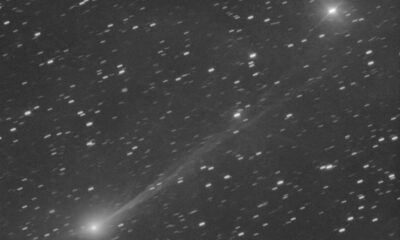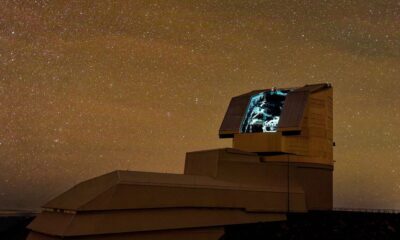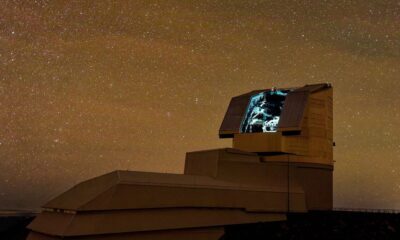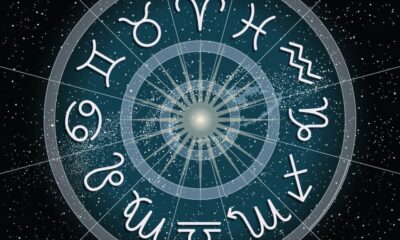Science
Astronomers Capture First Close-Up Image of Interstellar Comet
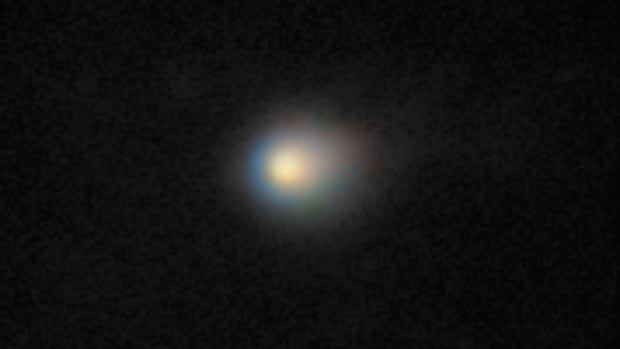
Astronomers have successfully captured the first detailed image of an interstellar comet, designated as 3I/ATLAS or C/2025 N1 (ATLAS). Discovered on July 1, 2025, near the orbit of Jupiter, this object exhibits a peculiar orbit that does not follow the typical path of asteroids or comets in our solar system. Using the U.S. National Science Foundation’s (NSF) Gemini North telescope in Hawaii, researchers have revealed the unique characteristics of this cosmic newcomer.
The comet is currently expected to remain visible through large telescopes until September 2025, after which it will be obscured by the sun’s glare. According to Martin Still, NSF program director for the International Gemini Observatory, the upcoming observations promise a wealth of new data that could illuminate the comet’s behavior as it absorbs sunlight while traveling through space.
Significance of the Discovery
The discovery of 3I/ATLAS is particularly exciting for astronomers, as it is only the third known interstellar visitor. Paul Wiegert, an astronomy professor at Western University, emphasized the importance of studying these objects, stating, “We are eager to learn about this entirely new class of object.” Comets and asteroids serve as remnants from the early formation of our solar system, providing valuable insights into the conditions of that time. Analyzing this interstellar visitor could enhance our understanding of other star systems.
Current estimates indicate that 3I/ATLAS has a diameter of approximately 20 kilometers, making it significantly larger than the previous two interstellar comets observed. The first, ‘Oumuamua, measured only 200 meters, while the second, 2I/Borisov, had a diameter of one kilometer. The size of 3I/ATLAS facilitates observation and study as it approaches Earth, with a close approach anticipated in December 2025, posing no threat to our planet.
Research presented by Matthew Hopkins at the Royal Astronomical Society’s National Astronomy Meeting 2025 suggests that this comet may be the oldest ever observed, potentially originating from a region of our galaxy known for its ancient stars. Hopkins estimates that it could be as much as seven billion years old, predating the formation of our galaxy, which is approximately 4.5 billion years old.
Understanding Its Origin
Astronomers can deduce the origins of comets and asteroids by analyzing their orbital eccentricity. This parameter indicates how elongated or circular the orbit is. An eccentricity of 0 represents a perfect circle, while values greater than 1 indicate that the object does not orbit the sun. The eccentricity of 3I/ATLAS is calculated at 6.2, confirming its interstellar origin. For comparison, ‘Oumuamua had an eccentricity of 1.2 and 2I/Borisov had an eccentricity of 3.6.
Currently, 3I/ATLAS is positioned approximately 465 million kilometers from Earth, with its closest approach projected for December 19, 2025, at about 270 million kilometers. It will reach its nearest point to the sun on October 30, 2025, coming within 210 million kilometers, just inside the orbit of Mars.
As research progresses, astronomers hope to uncover more about this remarkable interstellar visitor. Wiegert noted that 3I/ATLAS resembles a comet from our solar system, primarily composed of ancient ice that has been frozen for billions of years. As it approaches the sun, the object is beginning to sublimate, creating a fuzzy appearance with a tail that was captured in the recent image. The ongoing study of 3I/ATLAS promises to expand our understanding of these enigmatic celestial bodies and their origins.
-

 Politics4 weeks ago
Politics4 weeks agoSecwepemc First Nation Seeks Aboriginal Title Over Kamloops Area
-

 World5 months ago
World5 months agoScientists Unearth Ancient Antarctic Ice to Unlock Climate Secrets
-

 Entertainment5 months ago
Entertainment5 months agoTrump and McCormick to Announce $70 Billion Energy Investments
-

 Science5 months ago
Science5 months agoFour Astronauts Return to Earth After International Space Station Mission
-

 Lifestyle5 months ago
Lifestyle5 months agoTransLink Launches Food Truck Program to Boost Revenue in Vancouver
-

 Technology3 months ago
Technology3 months agoApple Notes Enhances Functionality with Markdown Support in macOS 26
-

 Lifestyle3 months ago
Lifestyle3 months agoManitoba’s Burger Champion Shines Again Amid Dining Innovations
-

 Top Stories2 months ago
Top Stories2 months agoUrgent Update: Fatal Crash on Highway 99 Claims Life of Pitt Meadows Man
-

 Politics4 months ago
Politics4 months agoUkrainian Tennis Star Elina Svitolina Faces Death Threats Online
-

 Sports5 months ago
Sports5 months agoSearch Underway for Missing Hunter Amid Hokkaido Bear Emergency
-

 Politics5 months ago
Politics5 months agoCarney Engages First Nations Leaders at Development Law Summit
-

 Technology5 months ago
Technology5 months agoFrosthaven Launches Early Access on July 31, 2025



